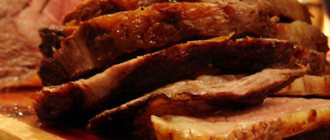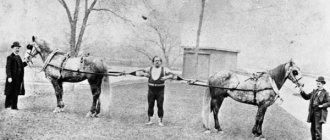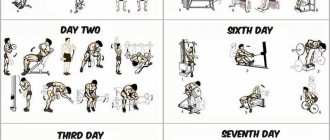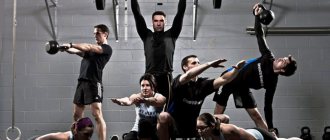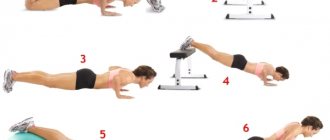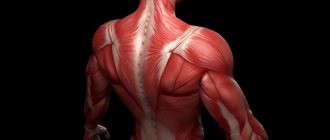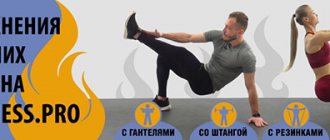Objectives of bodybuilding and powerlifting
Speaking of tasks, it is logical to consider the origin of two sports terms.
Bodybuilding (eng. body - body, building - construction) is a system of building a harmonious, sculpted body by increasing muscle mass on the one hand and reducing the percentage of fat on the other.
Powerlifting (English: power - strength, lifting - rise) is a sport aimed at increasing the strength of an athlete. In this case, such characteristics as relief and harmonious development of skeletal muscles play a secondary role.
Bodybuilding or powerlifting: which is better?
Body-building
(translated from English as “building the body”) is undoubtedly much better known.
This happened largely thanks to the Western film industry. Brutal and perfectly tailored guys who pump up their muscles are also called bodybuilders. They do not leave the pages of glossy magazines, and one stainless “Terminator” even happened to be the governor of California. You can be ironic about the popularity of this sport as much as you like, but the goals pursued by bodybuilders
are simple and worthy of respect. Everyone wants to have a beautiful and harmoniously developed body in order to stand out from the gray mass. But it’s one thing to want, and another to achieve. To perform well in competitions, you have to work hard for months and even years.
Competitive Features
An athlete must overcome challenges specific to each sport in order to achieve the final goal. This goal, as a rule, is to win competitions.
Competitive bodybuilding involves demonstrating the athlete's muscles in special poses, where judges evaluate the athlete according to the criteria of aesthetic proportions, volume and balance of muscles. It must be emphasized that in this sport the assessment is subjective. Often, competitions have categories that separate athletes by weight, age, and height. The first criterion is key.
Powerlifting competitions involve performing three so-called basic exercises: barbell squats, barbell horizontal presses, and deadlifts. The sum of the weights of all listed exercises determines the winner. As you can see, the assessment of an athlete in powerlifting is objective. Basic exercises got their name because they involve the largest number of muscles.
The competition also has a system of weight categories. A competitive feature is the possibility of using special equipment, which is either a mandatory attribute (non-supportive equipment) or helps to perform a strength exercise (supportive equipment).
Training speed - slow or fast
At first glance, the difference between the speed at which training is carried out is quite obvious. Olympic weightlifting, or bodybuilding, involves sets and reps being performed in quick succession, while in powerlifting the exercises are more extended and performed at a slower pace in order to create maximum tension and maintain his.
As a result of this difference in time between each subsequent repetition, bodybuilding tends to allow more misfires. When powerlifting, you usually have more time to perform a bench press or row properly.
Workout
The key stage in preparing for competitions is training. Here it is necessary to mention the similarities of some approaches in bodybuilding and powerlifting. For example, basic exercises are recommended for beginners planning to achieve results in both one and another sport.
Why do you need basic exercises >>
The main differences between the workouts:
- Bodybuilding involves two main training methods: gaining muscle mass and burning subcutaneous fat (“cutting”). Training is seasonal, that is, it alternates at certain intervals. In powerlifting, preference is given to training to increase strength.
- In terms of the number of repetitions, a bodybuilder performs a larger number of repetitions (9-12 or more) depending on the exercise. The powerlifter calculates the weight to perform 2-7 repetitions. The classic “basic” scheme is the five reps, five sets technique.
- The main exercises of a bodybuilder are exercises for building up lagging muscle groups (or muscles that are planned to be emphasized during performance). Powerlifters prefer competitive basic exercises.
- Depending on the number of workouts per week in bodybuilding, it is possible to train individual muscle groups every day. Powerlifting is focused on competitive, highly specialized compound lifts that are difficult to replace. Therefore, the athlete needs a certain period of rest and, accordingly, fewer training sessions per week.
Bodybuilders and powerlifters: how their training differs
The task of an athlete involved in powerlifting is to lift the weight as much as possible, based on his weight parameters. This task will require rigorous training that includes bench presses, power squats, and deadlifts—all competitive exercises.
The training cycle of powerlifters does not require a large number of exercises. The athlete does basic exercises and warms up the main muscle group during warm-up and after training. The training process can include exercises to develop auxiliary muscles, which will help increase performance when performing the basic part. Powerlifters usually train 3-4 times a week.
The basic cycle is performed in several approaches, as the athlete must restore strength, breathing and heart rhythm. The number of approaches can be up to 12 times. The entire training is aimed at preparing the athlete to perform the basic exercise. The main thing is not the number of approaches, but the generation of strength to lift the weight. The figure of powerlifters is distinguished by its impressive dimensions and disproportion.
When eating, athletes adhere to the basic rules and try to consume protein, carbohydrates, and fats in the quantities necessary for the muscles to grow, develop and have time to recover. To get into a certain weight category, an athlete before the competition adheres to a diet that will help maintain the basic strength capabilities of the body.
Powerlifting is a rather traumatic sport; the areas most commonly injured are the lower back, shoulder, knee, and neck.
Athletes-bodybuilders work on the formation of muscle mass, so their figure looks harmonious and proportional. In the training process of both bodybuilders and powerlifters, there are common core exercises in which they must perform the bench press, squats and deadlifts.
Unlike a powerlifter, a bodybuilder must do a large number of exercises to develop muscle mass. In order to properly develop certain muscle groups, you need to have a fairly large number of exercises in your training arsenal. In one workout, two muscle groups are usually worked out with decreasing and increasing loads. A bodybuilder's training program is usually scheduled for a month, which determines when the load will be increased or decreased.
Training most often takes place 3-5 times a week. Intense exercise prevents the muscles from falling into a relaxed state. Approaches alternate with short breaks (1-1.5 minutes). The training process can include elements from powerlifting aimed at increasing strength.
When performing exercises, the athlete does from 2 to 6 approaches, depending on the goals of the training process. A set can consist of 2-50 repetitions, although this is difficult, it is necessary for bodybuilders, who in their training often use the principles of powerlifters, whose priority is increasing strength. Bodybuilders train using the pumping principle, when they perform exercises in multiple repetitions.
Bodybuilders need to watch their diet when calculating the calories they need to stay in shape. When muscle mass is growing, the athlete adheres to a high-calorie diet, and when cutting, a low-calorie diet will be necessary.
Bodybuilding is a traumatic sport, but to a lesser extent than powerlifting.
What to choose - bodybuilding or powerlifting - depends on individual preferences and goals. Powerlifting is for those who want to develop their strength qualities. Bodybuilding, for those who want to form beautiful body contours. These sports have a lot in common.
Nutrition
Effective preparation of an athlete is based on three key factors: training, rest, nutrition. Regarding the latter, the main approaches are similar, but there are also specific differences.
For example, in the pre-competition period, a bodybuilder athlete must reduce the fat and water content in the body to an acceptable minimum. In contrast, reducing the percentage of water can have a detrimental effect on the joints of a powerlifter, who experience increased stress when lifting heavy weights.
Approved drugs based on creatine, which is involved in the process of performing high-intensity power loads (performed to failure in a short period of time), can be considered effective for powerlifting.
So, what is the difference between bodybuilding and powerlifting? First of all, these are radically different tasks of building a proportionate, developed body and increasing muscle strength. In accordance with the main goals, the approaches to achieving them in training, rest and nutrition differ. The final result of the evaluation of athletes is fundamentally different competitions demonstrating the harmonious development of their own body or its strength qualities.
Powerlifting is the toughest discipline
If you literally translate the name, you get “strength” and “raise.” The main task here is to maximize the possible increase in strength and traction. The main exercises are basic. Free weights are used and every muscle possible is used. Exercises such as deadlifts, bench presses and barbell squats are what work best. Because of the use of these three exercises, powerlifting is often called triathlon.
During the competition, athletes - “lifters” are given marks for each completed task, after which they are summed up. The participants' results are then compared. A high score and low weight will determine the winner.
You can only meet a powerlifter who does this professionally at competitions; they are not available in regular gyms. This is due to the fact that there is no element of competition in the hall, which means there is no interest in such a place.
As has already become clear, the first place is always the opportunity to prove your superiority in strength. Then comes the health and beauty of the body.
The exercises of a powerlifter have significant differences from the disciplines already discussed. All the work consists of practicing three exercises and repeating them endlessly. They do not use other exercises. As a rule, exercises are repeated no more than three times, often just one approach. But this approach is performed with the maximum allowable weight and surrounded by a larger number of belayers.
In order for the results to be impressive, the athlete must concentrate as much as possible during the exercise, since the risk of injury is very high, and this can lead to abandonment of training for a long time. Rest also takes longer, in some cases up to ten minutes.
There are no difficulties in the process of nutrition during powerlifting. The main thing is that the body fully receives all the necessary carbohydrates, fats and protein. Preference is given to high-calorie foods that can meet the body's needs. At the same time, there is no need to maintain or achieve relief, or dry the body.
Now it has become extremely clear what fitness, bodybuilding and powerlifting are and what differences they have among themselves.
Let's figure out what fitness is.
During their school years, during physical education classes, everyone performed a number of simple exercises designed to strengthen the growing body. So, fitness, in general, also has meaning, but includes a wider range of activities. In most cases, fitness is associated with aerobics or the gym, which is not entirely true. This discipline includes any regular active physical activity that helps to improve the health of the body, strengthen and maintain tone. That is, swimming, cycling and even morning exercises can be considered a discipline.
The essence of bodybuilding
Literally, “bodybuilding” translates as “building the body.” The goal of a bodybuilder is to create a beautiful and high-quality body with a large percentage of muscle mass (more about this here - https://cross.expert/dlya-nachinayushih/bodybuilding.html).
To do this, athletes practice basic and isolated exercises. However, in bodybuilding competitions, competitors are not required to lift a barbell. Athletes go on stage, and the jury evaluates their appearance - the development of all muscles, the correctness of proportions and body contour.
In addition to training, bodybuilders pay great attention to their nutrition, including large amounts of proteins and carbohydrates in their diet. Before competition, carbohydrate intake is reduced so that the body burns almost all subcutaneous fat, using it as an energy source.
The body becomes more prominent, the muscles under the skin are drawn and look more voluminous.
What is the difference between bodybuilding and powerlifting?
You need to clearly understand that in order to pump up large muscles with a beautiful shape, you need to train in one way, and in order to lift or push the maximum weight at one time, you need to train in a completely different way.
A lot of weird guys, whom I call dry-headed thinkers, often talk about how BIG MUSCLES DON'T WORK, or that it's not natural, or that the bigger the closet, the louder it falls, etc. This is pure nonsense.
MUSCLE VOLUME IS NEVER USELESS! You need to remember this. Understand that if your body decided to grow large “cans” for itself, then there were VERY GOOD reasons for this! The body will never do anything that is not beneficial for it!
If we now plunge into the world in which our ancestors lived, then from the point of view of “usefulness,” what skill did our distant grandparents need more?
One primitive man found a very large stone and lifted it once to surprise his fellow tribesmen.
And the second Cro-Magnon man, who found many stones of moderate weight and size and dragged them around to build himself a shelter.
Which has more valuable skills from an evolutionary point of view? I think the answer is clear.
Large muscles are an indicator that a person is able not only to lift weights, but also to do it for a long time and intensively . This is why girls like muscular guys. Because this is an indicator that a male (male) can WORK hard, long and intensely.
Another example . Let's say a primitive man killed alone (which is unlikely) a large boar and is going to drag it to his shelter to skin it.
So he makes a jerk and rests for 3-5 minutes, then another jerk. But another primitive man in the same situation made 6-12 jerks, rested for a minute and again 6-12 jerks. Who will feed the hungry lady in his cave faster? Obviously the second ancestor. And which of these two Cro-Magnons is the lady most likely to give?
Now we should more or less get to the core of bodybuilding. Our goal to make our muscles bigger is to activate and exhaust our muscles with heavy, intense strength training.
This is what will lead to hypertrophy of our myofibrils and sarcoplasmic elements.
Now it’s time to specifically consider the essence of training a bodybuilder to achieve maximum muscle volume and a powerlifter to achieve maximum strength.
The essence of a bodybuilder's training
Purpose of training: Activation and exhaustion of muscles with power, intense load.
Number of repetitions: 6-12.
Muscle failure: should occur within 10-30 seconds.
Rest between sets: 45-120 seconds.
Rest between workouts: 48-72 hours.
Muscle groups involved in training: 2-3 split.
Training volume: Large (many approaches in a short period of time).
What is the “trick” of large muscles?
In this article I have to show the essence of those things that most beginner bodybuilders do not understand.
As I said above, everyone who works out in the gym faces the question: “How to train?” How many repetitions to do, how long to rest between sets, in what order to perform exercises to build large muscles, etc.
First, it’s worth understanding what “big muscles” actually are.
Our muscles are not homogeneous . Those. consist of various structures, most of which can increase, BUT each of these structures grows and increases under different types of influence on it. Some give greater muscle volume, some more modest.
The largest muscle volume is given by:
- MYOFIBRILLS (“muscle threads”, fibers).
- SARCOPLASMA (glycogen, mitochondria, etc.).
Myofibrils are also divided into several types:
- High-threshold fast muscle fibers (HTF).
- Fast-twitch muscle fibers (FMTs).
- Slow-twitch muscle fibers (SMF).
Each type of myofibrils is designed and grows under different loads, with different types of glycolysis (anaerobic, aerobic), etc.
Fast-twitch muscle fibers are designed to perform high-volume work, so they are of greatest interest to bodybuilders.
High-threshold fast-twitch muscle fibers are designed to overcome very high loads, but in a low number of repetitions, i.e. just for the load that powerlifters and weightlifters overcome.
And slow-twitch muscle fibers are needed to overcome low-intensity loads, but over a very long time. For example, for long-distance running, etc.
How to build big muscles?
Obviously, in order to pump up large muscles you need to train:
Fast twitch muscle fibers + sarcoplasm (energy tanks)
Those. you will hypertrophy your myofibrils and increase the volume of energy tanks (sarcoplasm).
Your larger myofibrils (muscle fibers) will give you strength, and your larger volume of sarcoplasm will give you the energy to work your muscles for long periods of time. In short, you will be able to perform high-volume strength work .
Bodybuilding vs Powerlifting
Very often people ask questions about rest between sets, training frequency, and repetition range. Every person faces this question not only at the beginning of training. In my opinion, many often do not understand the essence, i.e. what their training is aimed at. This is exactly what we will deal with in this article.
Hello! Nowadays you can find tons of information on how to gain muscle mass. Some training schemes are more effective, some are less effective. The training system of “The Rock”, Vin Diesel, Arnold Schwarzenegger, Mike Mentzer and others. Everyone has their own training principles. Who to believe? How to understand different techniques? How is bodybuilding different from powerlifting? I will consider these and many questions in this article.
I'm a little scared by people who always try to prove to everyone that their scheme works. Arguing with people who believe that they have known the truth and are not looking for it is simply useless!
A true specialist is always in search of better ways and his mind is always open to new information that opens up completely new horizons. After all, the mind was given to us specifically in order to analyze everything that happens around us.
Someone might say: “Dude, look at Arnold and you’ll immediately understand everything!” I would not say this so confidently, because... What many don't know is that the monstrous high-volume training that Arnie trained in will simply kill many. The fact is that Arnold, from childhood, as soon as he started going to the gym, used steroids (mostly oral, like methandronstenolone). This is what, in many ways, helped him progress so much and smooth out the corners of his far from imperfect training schemes.
I don’t say this to downplay his work. Arnold is the greatest athlete with incredible tenacity! I say this only to show that everything in the world is changing, including the principles of the training process.
